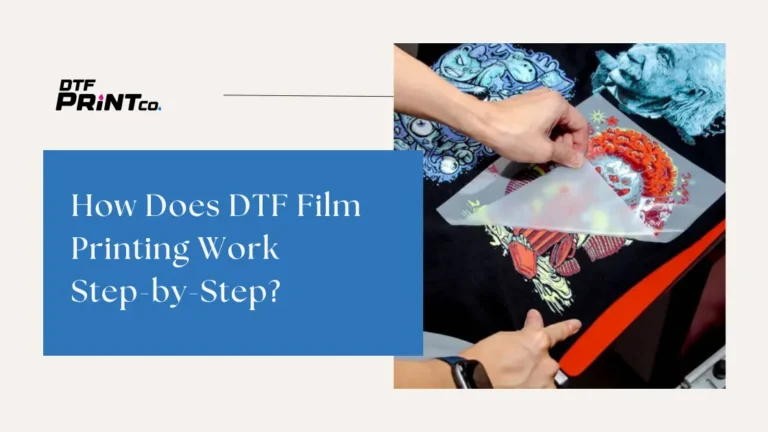
DTF vs DTG Printing: Which Is Better for T-Shirts?
Both DTF (Direct-to-Film) and DTG (Direct-to-Garment) printing are popular methods for customizing t-shirts, but each method has its strengths. DTF printing works well on various

The fashion industry is always changing. Trends come and go, but sometimes, new technology can revolutionize the entire market.
One of the biggest recent changes is the rise of DTF (Direct-to-Film) transfer. This technique is transforming how clothing is customized and produced.
Let’s examine why DTF transfers are revolutionizing the fashion industry and how they could affect what you wear.
DTF transfer stands for Direct-to-Film transfer, a new way to print designs onto fabric. It involves printing your design onto a special film and transferring it to the garment using a heat press. Unlike older methods like screen printing or Direct-to-Garment (DTG), DTF works with many fabric types, not just cotton.
But why is it so popular? The answer lies in its versatility and ease of use. DTF allows vibrant designs to be transferred onto fabrics of different colors and textures, from polyester to nylon. It’s easier and quicker to set up than traditional screen printing, making it a favorite choice for small businesses and custom clothing shops.
Versatility
DTF transfer can work with almost any kind of fabric. Whether it’s cotton, polyester, nylon, or a blend, DTF makes it possible. Traditional printing methods can struggle with some fabrics, but DTF doesn’t have this issue. This versatility means brands can create more options for consumers.
Vibrant Colors and Durability
DTF prints are known for their vivid colors and durable results. The colors tend to “pop” on any fabric, making the design eye-catching. Unlike other printing techniques, DTF prints stay vibrant even after multiple washes. This durability is essential, especially when customers want their favorite T-shirt design to last long.
Cost-Effectiveness
DTF transfer is also cost-effective compared to other printing methods. It requires less equipment or labour than traditional methods like screen printing. Small quantities can be produced without a significant cost, making it ideal for custom orders or limited-edition releases.
You may know other methods like screen printing and Direct-to-Garment (DTG). Each has its strengths, but DTF is carving out its place as the go-to for customization. Let’s compare:
As you can see, DTF has advantages that make it a great all-around option for today’s market.
You may be wondering who benefits the most from this technology. Small businesses and custom print shops are the biggest adopters. Since DTF doesn’t need the same costly setup as screen printing, it’s great for small orders and even one-off prints. It’s also perfect for designers looking to test a new concept without making hundreds of pieces in advance.
Streetwear brands are also taking advantage of DTF. The ability to print vibrant, long-lasting designs on various garments means they can create unique pieces without worrying about fabric limitations. Even more prominent brands are beginning to look at DTF for limited-edition releases or collaboration pieces.
So, what does this mean for you? DTF transfer makes getting high-quality, custom clothing easier without paying a fortune. Want a unique T-shirt that no one else has? DTF can make that happen. Whether it’s a personal gift or a unique piece for your wardrobe, the technology behind DTF transfers makes customization easy and affordable.
Not only is it good for custom orders, but it’s also pushing eco-friendly options. Because DTF can work with small quantities, there’s less waste than bulk printing. This is an important step for a fashion industry looking to reduce its environmental impact.
Imagine you could create any design on a piece of clothing. What would it be? A picture of your pet? A favorite quote? With DTF, these designs can become a reality. The next time you see a custom clothing shop, remember that they may use this exciting new tech to make your vision come true.
If you’ve ever wanted to start a small clothing line or try making your designs, DTF transfer is a simple and accessible way to do it. It’s fast, doesn’t cost too much, and provides great results.
Is DTF better than screen printing?
It depends on your needs. DTF is more cost-effective for small, customized orders, while screen printing may be cheaper for large runs.
Can I wash clothes with DTF prints?
Yes, garments with DTF prints can be washed without losing quality. Just follow regular care instructions, like washing on a gentle cycle.
Can DTF transfer be used on all types of fabrics?
Yes, DTF works well on most fabrics, including cotton, polyester, and blends.
How does DTF compare to heat transfer vinyl (HTV)?
DTF offers more vibrant colors and is easier to use on different types of fabrics compared to HTV. Plus, DTF designs are generally more durable.
The rise of DTF transfer is changing the fashion industry, making it easier for small brands and independent designers to thrive. With versatility, vibrant colors, and cost-effectiveness, it’s no wonder DTF is becoming popular. Whether looking for a unique outfit or considering launching your line, DTF could be the key to making your ideas come to life.

Both DTF (Direct-to-Film) and DTG (Direct-to-Garment) printing are popular methods for customizing t-shirts, but each method has its strengths. DTF printing works well on various

Direct To Film (DTF) printing is rapidly becoming a popular choice for custom apparel and garment decoration. Unlike traditional screen printing or direct-to-garment (DTG) methods,

If you’ve ever dreamed of creating your own custom shirts, hoodies, or tote bags without spending a fortune or dealing with messy screens, there’s some

2023 - 2024 © ALL RIGHTS RESERVED